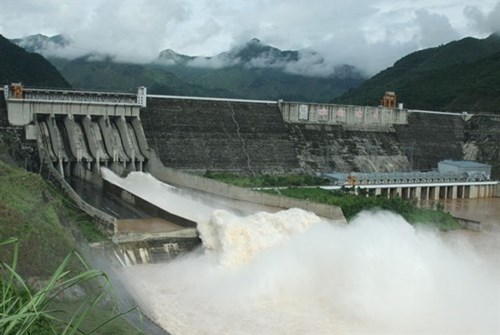If the worst-case scenario comes to pass, Hoai said, and the dam of the Hoa Binh Hydroelectricity Plant breaks, the water will be directed to different areas to minimise danger and economic losses.
"According to the plan, we are not allowed to let the Hoa Binh Hydropower Plant’s dam break. It is necessary to actively divide the water and keep the dams safe and ensure the security of the people,” said Hoai.
    |
 |
|
Son La Hydropower Plant, the largest hydropower plant in Vietnam and Southeast Asia, will have to open its floodgates to discharge water to ensure safety if necessary |
In developing the inter-lake operation plan, the steering committee aimed not to let the dams break. In response to the floods, the committee built a reasonable flood diversion plan, he said.
Dao Trong Tu, Director of the Centre for Sustainable Development of Water Resources and Adaptation to Climate Change, said that it was necessary to examine and assess the safety of all hydropower dams in the whole region, and to work out appropriate safety measures.
Over the past three years, the Ministry of Industry and Trade (MOIT) removed 471 hydroelectric projects, including eight large hydropower projects and 463 small hydropower projects, due to problems with the projects. They also rejected construction plans for 213 others. Of the small hydropower projects in the country, 245 are operating, 162 are under construction and 230 others are under study.
Most of the projects removed by the MOIT are located in mountainous areas of the central and Central Highlands provinces and were constructed and run by private enterprises.
A review showed that Gia Lai province in the Central Highlands had 74 hydropower projects. After the study, the province has eliminated 17 small and medium hydropower projects with total capacity of over 44MW. Many of the projects had very small capacity, from 0.25MW to 0.6MW.
With mountainous terrain and dense rivers and streams, many northern mountainous provinces set up hydropower plants with the expectation that they would bring economic benefits. However, a series of problems caused by small and medium hydropower projects has resulted in dampened enthusiasm.
Professor Vu Trong Hong, Chairman of the Vietnam Irrigation Association, said that water discharged from small hydroelectric plants is even greater than natural flood waters. Because the plants have small reservoirs, there is little capacity for flood prevention, so when the reservoir fills with water, it must discharge a large quantity of water downstream.
The northern province of Cao Bang removed 11 projects from the plan in 2011, while 40 others are still in the planning stages with total capacity of over 350MW. Scientists said that the impact assessments for small and medium hydroelectric power plants in localities had not been carried out well, leading to low management quality. Some projects were not suitable with other plans for irrigation, transport and electricity, or had low economic efficiency.
The Hoa Binh Hydropower Plant is located in the northern province of Hoa Binh on the Da River. Built by the Soviet Union beginning in 1979 and operational since 1994, this was the largest hydropower plant in Vietnam and Southeast Asia when it was inaugurated. Its designed capacity is 1,920MW. Its annual electricity output is 8.16 billion KWh.
The Son La Hydropower Plant is also on the Da River in Muong La district in the northern province of Son La. Construction on the plant, with capacity of 2,400MW, started on December 2, 2005. The plant was inaugurated in 2012 and became the largest hydropower plant in Vietnam and Southeast Asia.
Source: VNA